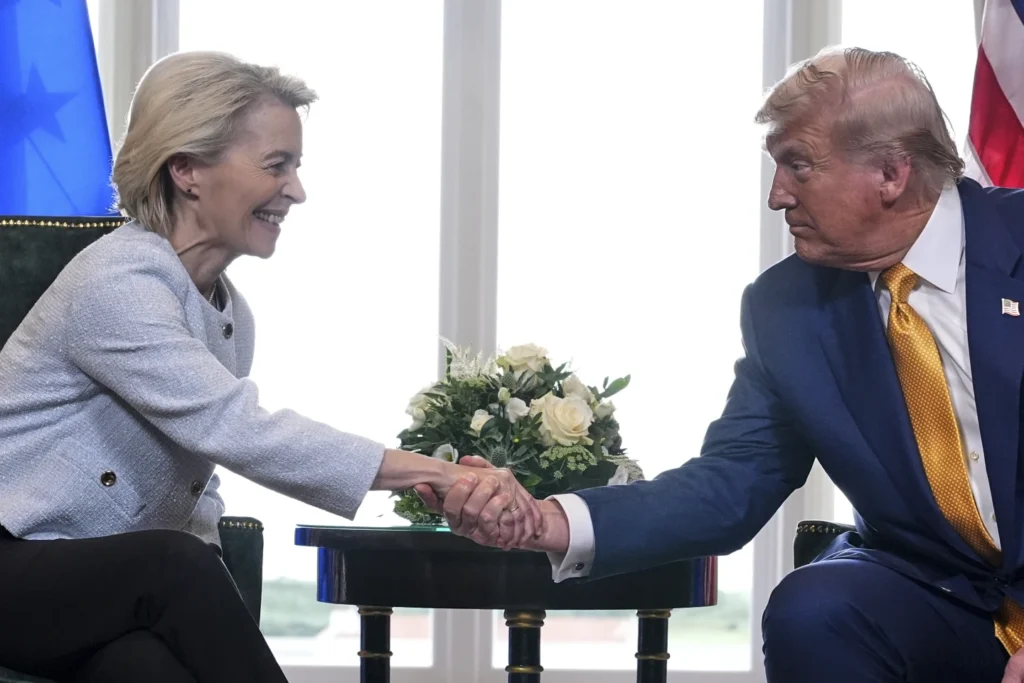US-EU Trade Deal Prevents Tariff Escalation, Raises Costs/ Newslooks/ WASHINGTON/ J. Mansour/ Morning Edition/ The U.S. and European Union reached a trade agreement that avoids steeper tariffs but imposes a 15% rate on most EU imports. While easing geopolitical tensions, the deal is expected to raise prices for U.S. consumers and slow EU economic growth. Many terms remain unresolved, and criticism from European leaders reflects unease about the deal’s economic implications.

US-EU Trade Deal Quick Looks
- Agreement imposes a 15% tariff on about 70% of EU goods
- Prevents Trump’s threatened 30% tariff, down from earlier threats of 50%
- Deal excludes many specifics, remains nonbinding until formalized
- Tariffs will raise consumer prices in U.S. and pressure EU exporters
- EU to purchase $750B in U.S. energy over three years
- European companies pledged $600B in U.S. investment, not legally binding
- Zero-tariff categories include aircraft parts, semiconductors, raw materials
- Steel tariffs remain at 50%; no deal on pharmaceuticals
- Auto sector faces mixed outcomes: Volkswagen hit, Mercedes guarded
- Economists warn of GDP loss, price hikes, trade imbalances
- Germany supports the pact; France calls it unequal
- Full legal terms expected later; current framework lacks enforcement mechanisms

Deep Look: US-EU Trade Deal Avoids Escalation but Raises Economic Concerns
The United States and European Union have struck a provisional trade deal that aims to avert escalating tariffs, but at the cost of higher prices for consumers and slower growth for both economies. The agreement, reached between President Donald Trump and European Commission President Ursula von der Leyen, sets a 15% tariff on roughly 70% of EU goods imported into the U.S., including cars, microchips, and pharmaceuticals.
Though this rate is significantly lower than the 30% Trump threatened to implement by August 1, and far below his earlier calls for a 50% levy, the deal marks a stark increase from the current 1.2% average tariff on EU goods. European economists expect the higher rate will shave 0.5% off the European Union’s GDP, citing reduced exports and lower profitability for firms operating in the transatlantic market.
The announcement followed a meeting between Trump and von der Leyen at Trump’s Turnberry golf resort in Scotland. Despite the high-level diplomacy, the agreement is not yet legally binding. Officials from both sides say a formal joint statement will be issued soon but acknowledge that many sections of the agreement still require clarification or negotiation.
Unresolved Elements and Strategic Carveouts
One of the few specific achievements of the pact is a zero-tariff provision for a select group of strategic goods, including:
- Aircraft and aircraft parts
- Certain chemicals and semiconductor equipment
- Select agricultural goods and raw materials
- Products like nuts, seafood, pet food, and dairy
However, 30% of EU imports remain outside the agreement’s current scope, pending further decisions. Pharmaceuticals—one of the EU’s key exports to the U.S.—have been left out for now, with von der Leyen indicating that they are being negotiated separately.
Trump’s 50% tariff on imported steel will also remain in place. The U.S. and EU committed to additional talks aimed at managing the global steel glut and establishing import quotas.
Energy and Investment Promises
In an effort to rebalance trade flows, EU nations agreed to purchase $750 billion in U.S. energy products over the next three years. This includes natural gas, nuclear fuel, and oil, aligning with the EU’s long-term strategy to reduce dependency on Russian energy.
European companies also pledged $600 billion in additional investment in the U.S., although officials emphasized this was a political commitment, not a binding obligation. Critics argue that such pledges provide little guarantee of execution without enforceable clauses.
Impact on the Auto Industry
The auto sector finds itself in a precarious position. European automakers like Volkswagen have already reported substantial financial hits; the company reported a €1.3 billion loss in the first half of 2025 due to tariffs. Mercedes-Benz dealers have temporarily held 2025 prices steady but acknowledged that price hikes are inevitable.
While the 15% tariff is lower than the existing effective rate of 27.5%—which includes a 25% Trump-era tariff and a baseline 2.5% auto import tax—the sector remains cautious. Mercedes-Benz benefits from a partial tariff shield by assembling 35% of its U.S.-sold vehicles in Alabama.
Political Reaction: Praise, Criticism, and Skepticism
Reaction across Europe was mixed. German Chancellor Friedrich Merz praised the agreement for preventing a more severe trade rupture and preserving critical EU interests. However, French officials were far more critical. Clément Beaune, EU Strategy Commissioner, described the agreement as “unequal and unbalanced,” saying Europe failed to leverage its strength as the world’s largest trading bloc.
Economists have also raised flags. ING’s global macro chief Carsten Brzeski warned that the agreement, while helpful in calming markets, lacks legal force.
“At face value, the deal ends a major source of global uncertainty. But until terms are formalized, the risk of renewed tensions remains.”
Trade Balance and Historical Context
Prior to the Trump administration’s return, the U.S.-EU relationship was defined by generally low tariffs and high trade volume, totaling roughly €1.7 trillion ($2 trillion) annually. The transatlantic alliance constitutes 44% of global GDP, making it the largest bilateral trade relationship worldwide.
Despite its size, Trump has long criticized the EU’s €198 billion ($232 billion) goods trade surplus with the U.S. and accused Europe of protectionism—particularly regarding U.S.-made automobiles.
Still, American companies dominate in service exports, including technology, legal services, and finance. According to the European Central Bank, around 30% of EU imports are sourced from American-owned entities operating within Europe, a statistic that complicates the trade balance narrative.







